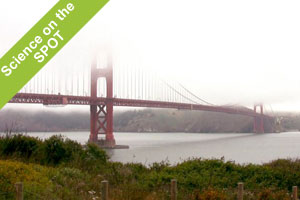 While foggy days aren’t ideal for a summertime picnics, coastal fog does benefit the ecology of the Bay Area.
While foggy days aren’t ideal for a summertime picnics, coastal fog does benefit the ecology of the Bay Area.
Normally I wouldn’t be hoping for a chilly, foggy day during the summertime here in San Francisco. For the purposes of filming our Science on the SPOT story, “Science of Fog,” however, we hoped that the Presidio would be socked in with a thick blanket of fog for our interview with UC Berkeley’s Todd Dawson.
Luckily, Mother Nature cooperated with us to give us plenty of atmospheric fog to work with for our shoot. We interviewed Dawson about the two types of fog that are prevalent in the Bay Area, and about his ongoing research on the decline of fog along the California coast.
Dawson also elaborated on some conflicting reports in the media on whether fog was declining or actually increasing. “There was a study done previous to ours over a shorter period of time. It’s only about 35 years. And the records came only from the Los Angeles area and from San Francisco. They weren’t a comprehensive sort of investigation of all of the temperature records that we’ve done throughout California.
Those investigators came to the conclusion based on a model that they had developed based on those just temperature records, [with] no fog data. They ran the model, and it gave them an output that says, ‘Oh, fog is going to be increasing.’
